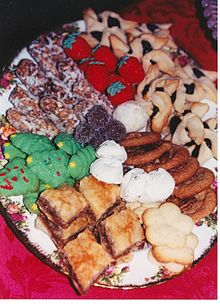Spritzgebäck
This article needs additional citations for verification. (March 2013) |
This article may be expanded with text translated from the corresponding article in German. (November 2020) Click [show] for important translation instructions.
|
 | |
| Type | Biscuit / Cookie |
|---|---|
| Place of origin | Germany, France (Alsace and Moselle) |
| Main ingredients | flour, butter, sugar, eggs |

Spritzgebäck is a type of German and Alsatian-Mosellan Christmas biscuit or Christmas cookie made of flour, butter, sugar and eggs. When made correctly, the cookies are crisp, fragile, somewhat dry, and buttery. The German verb spritzen means to squirt in English. As the name implies, these cookies are made by extruding, or "squirting", the dough with a press fitted with patterned holes (a cookie press) or with a cake decorator, or pastry bag, to which a variety of nozzles may be fitted. In the United States, the name Spritzgebäck is often shortened to spritz becoming known as the spritz cookie.[1]
Spritzgebäck is a common pastry in Germany and served often during Christmas season, when parents commonly spend afternoons baking with their children for one or two weeks. Traditionally, parents bake Spritzgebäck using their own special recipes, which they pass down to their children.
See also[]
- List of German desserts
 Food portal
Food portal
References[]
- ^ Dede Wilson (11 October 2011). Baker's Field Guide to Christmas Cookies. Houghton Mifflin Harcourt. p. 146. ISBN 978-1-55832-628-6. Retrieved 19 April 2012.
External links[]
- Alsatian cuisine
- German cuisine
- German desserts
- Christmas in Germany
- Biscuits
- Christmas food
- Dessert stubs
- German cuisine stubs